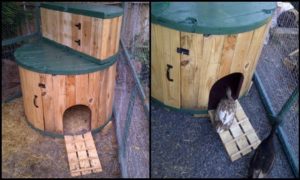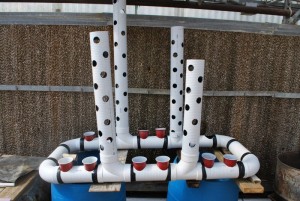Last Updated on February 19, 2024 by teamobn
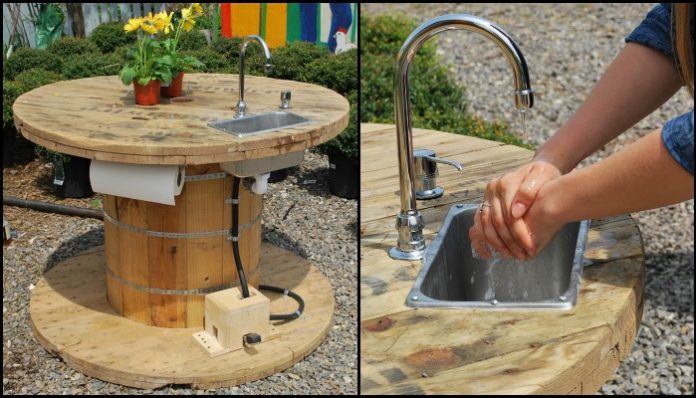
Now here’s a great idea for an outdoor kitchen or garden! This old wooden cable spool has been transformed into a one-of-a-kind outdoor sink to make your outdoor dinners and gardening activities more convenient – perfect for any garden or patio!
An old wooden cable spool is a cylindrical piece of wood used to wind and store cable. These spools can be made from various woods, but are most commonly made from oak or maple. Cable spools can be found in various sizes, but are typically between 24 and 48 inches in diameter.
This easy DIY wooden cable spool project will surely add charm and functionality to your outdoor space. It works via a foot pump, which means there is less mess since you do not have to touch the sink while your hands are still dirty.
And it provides a large, spacious work surface area, making it very convenient for outdoor cooking or washing up your backyard harvest! Other features include a water level gauge and an integrated soap dispenser.
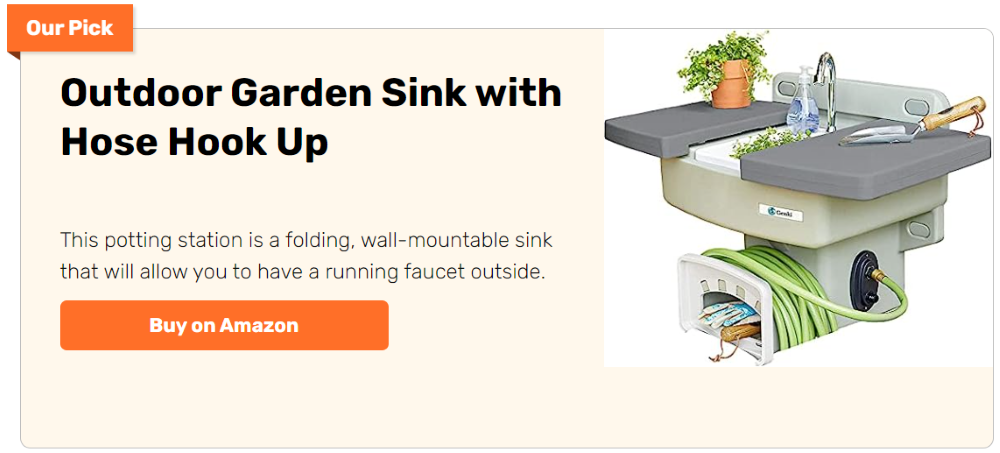
You can get more details from Naha Do over at Behance!
Click on any image to start the lightbox display. Use your Esc key to close the lightbox. ![]()
Contents [show]
- 1 Unique Outdoor Sink Ideas
- 2 Sustainability and Eco-Friendly Options
- 3 Safety and Accessibility
- 4 FAQ on Sustainable Outdoor Sinks
- 4.1 Can I make an outdoor sink from any old wooden cable spool?
- 4.2 What makes a wine barrel sink a luxury addition to outdoor spaces?
- 4.3 How can I ensure my garden sink is mobile?
- 4.4 Is it difficult to install water-saving features in an outdoor sink?
- 4.5 How do I maintain the sustainability of my outdoor sink?
- 4.6 Can I customize my outdoor sink to match my garden’s aesthetic?
- 4.7 Are there any considerations for the placement of an outdoor sink?
- 4.8 How can I ensure my outdoor sink is accessible to everyone?
- 5 Conclusion
Unique Outdoor Sink Ideas
A wine barrel outdoor sink is a great way to add a touch of luxury to your outdoor space. This is usually made from a repurposed wine barrel, which gives it a unique and rustic look. They are often used in high-end outdoor kitchens and entertaining areas.
They can add a touch of elegance to any space, and they are also functional and practical. If you are considering adding one to your outdoor space, there are a few things you should keep in mind. You will need to find a suitable location for your it. It should be in a spot that is convenient for you and your guests, and it should also be able to withstand the elements.

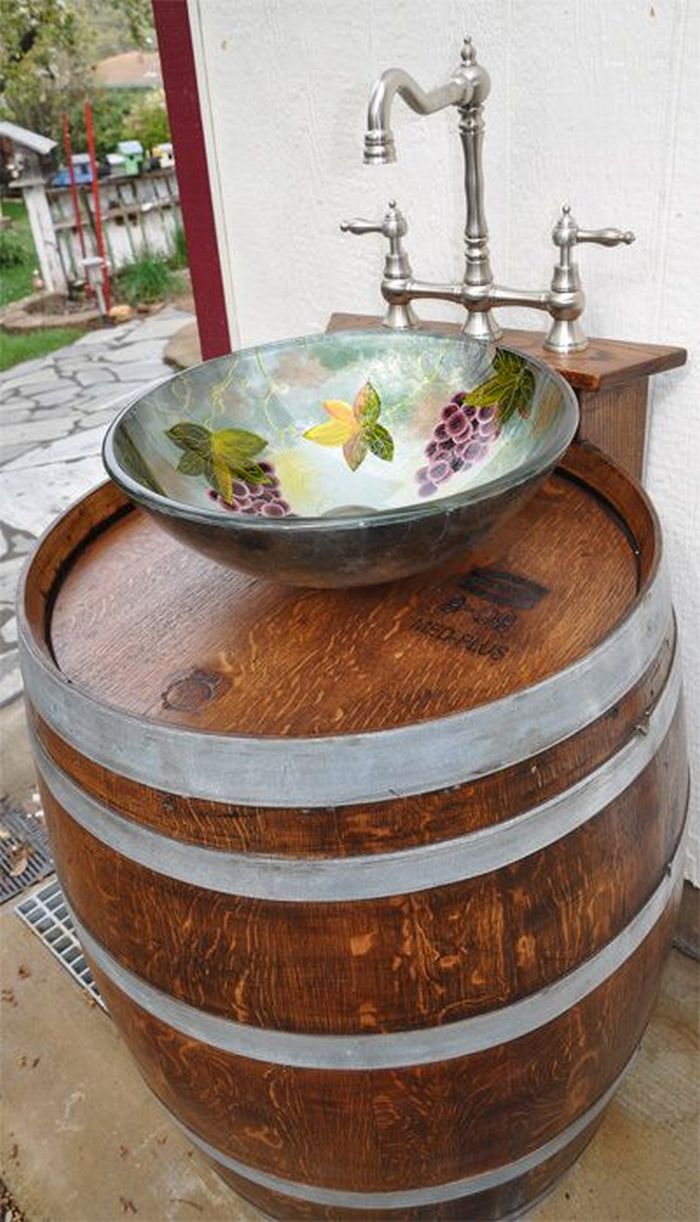
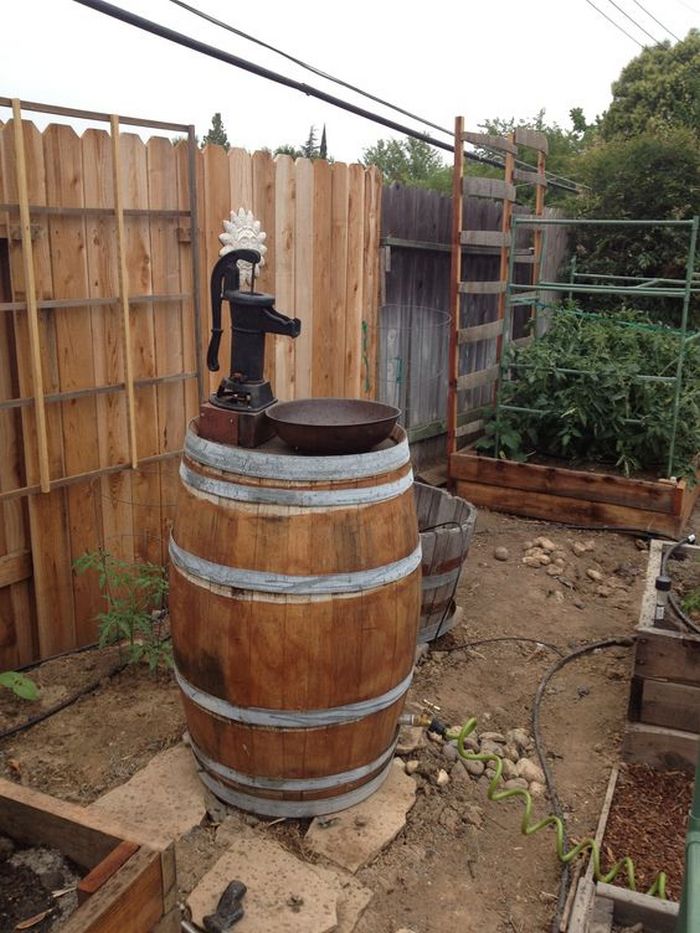
If you’re tight on space in your garden, or you just want to be able to move your garden sink around, then this is a great option. You can find ones that are made out of a variety of materials, including plastic, metal, and even wood.
They come with built-in drainage, so you don’t have to worry about where the water will go. And, if you choose a model that has wheels, you’ll be able to easily move it around your garden as needed.
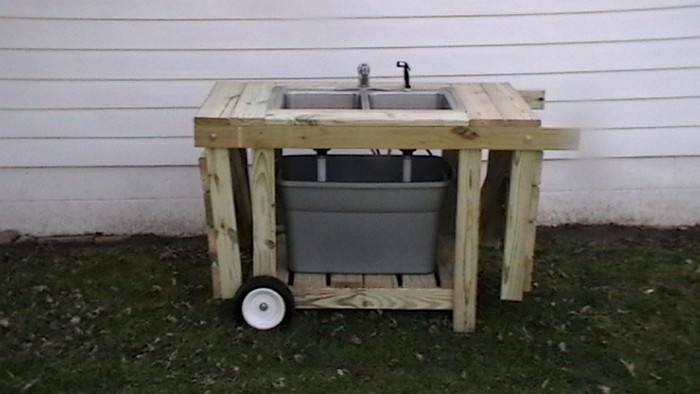
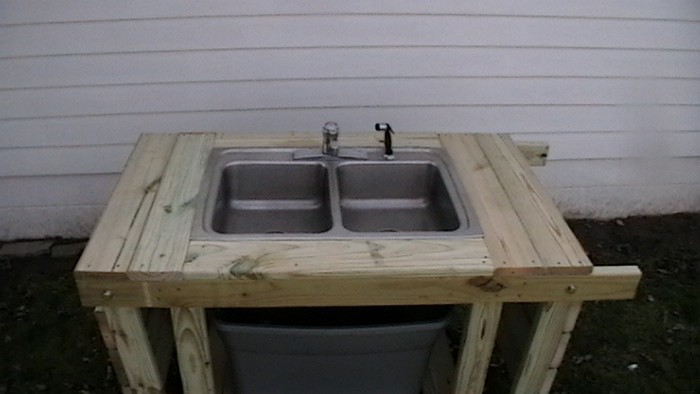
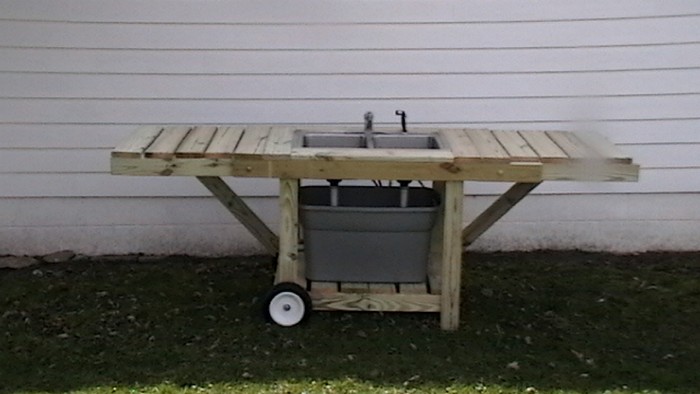
This galvanized bucket sink is the perfect addition to any rustic or industrial-style outdoor space. The sleek, metal design is both stylish and functional, and it’s sure to make a statement in any room. This is made from high-quality materials and is built to last. It’s the perfect choice for anyone looking for a unique and stylish sink for their outdoor space.
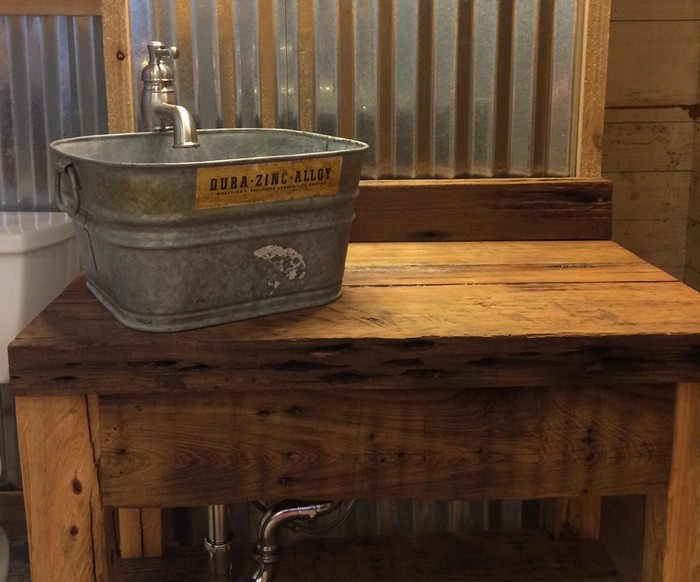

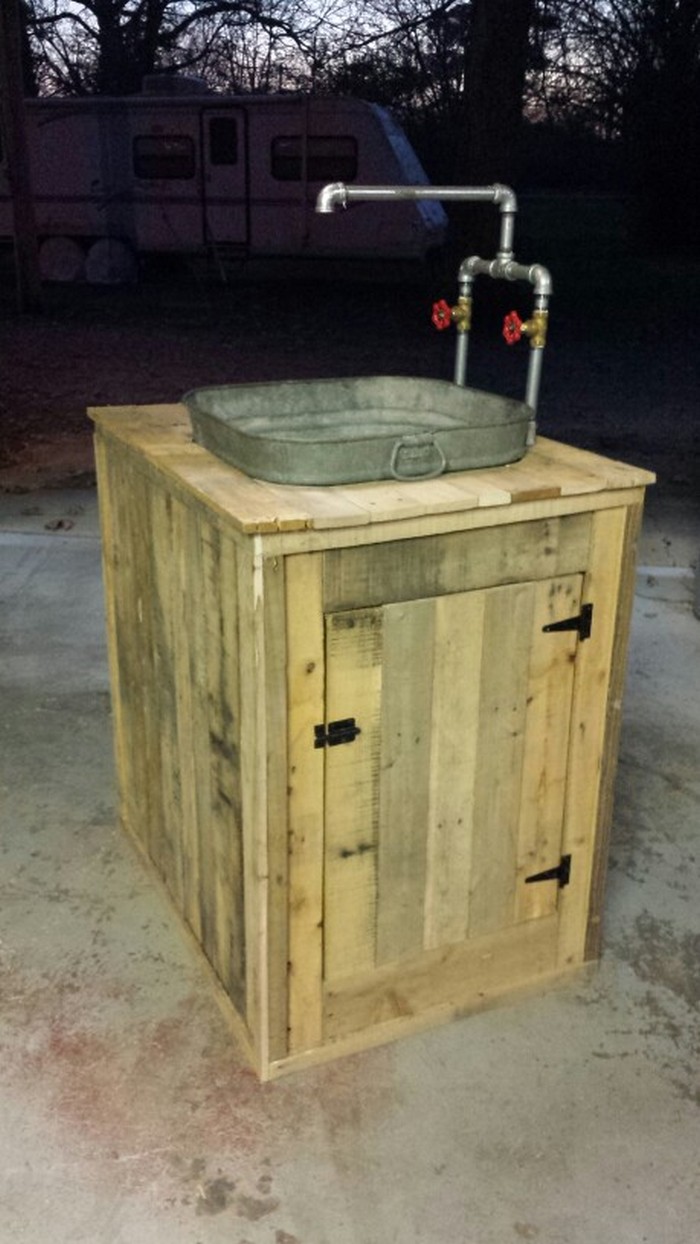
Pallet
If you’re looking for a creative and unique way to add a sink to your outdoor space, consider using a pallet. With some basic carpentry skills, you can easily turn a pallet into an outdoor sink. To start, you’ll need to find a pallet that is in good condition and of a suitable size.
Once you have your pallet, you’ll need to sand it down and remove any nails or splinters. Once your pallet is prepped, you can begin attaching the sink fixtures. Depending on the style of sink you want, you may need to drill holes for the faucet and drainage. Once your sink is installed, you can add a backsplash and countertop if you want.
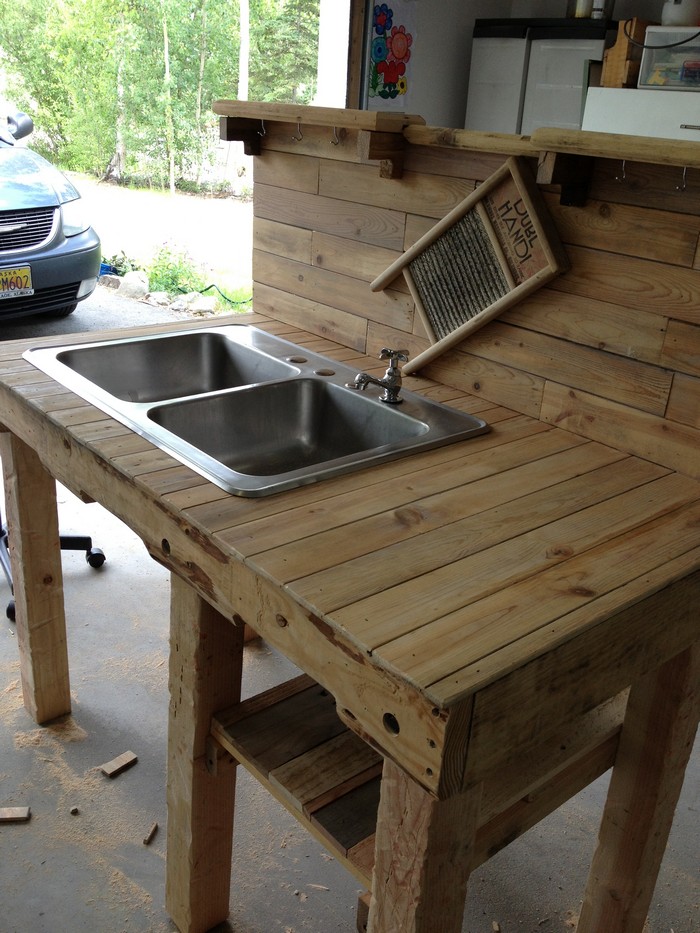
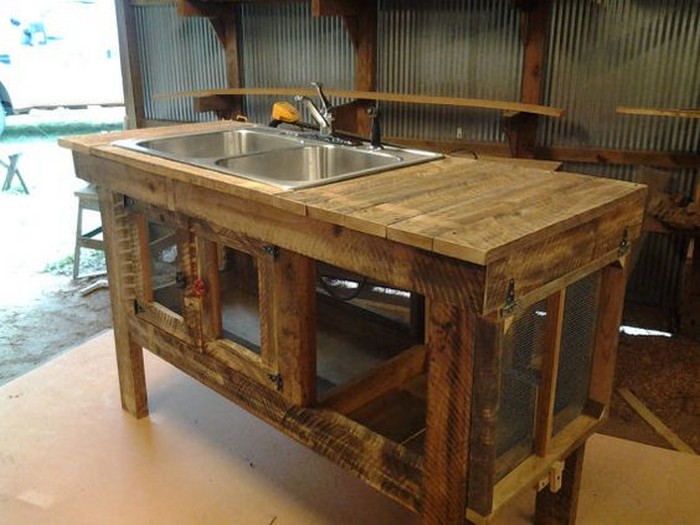
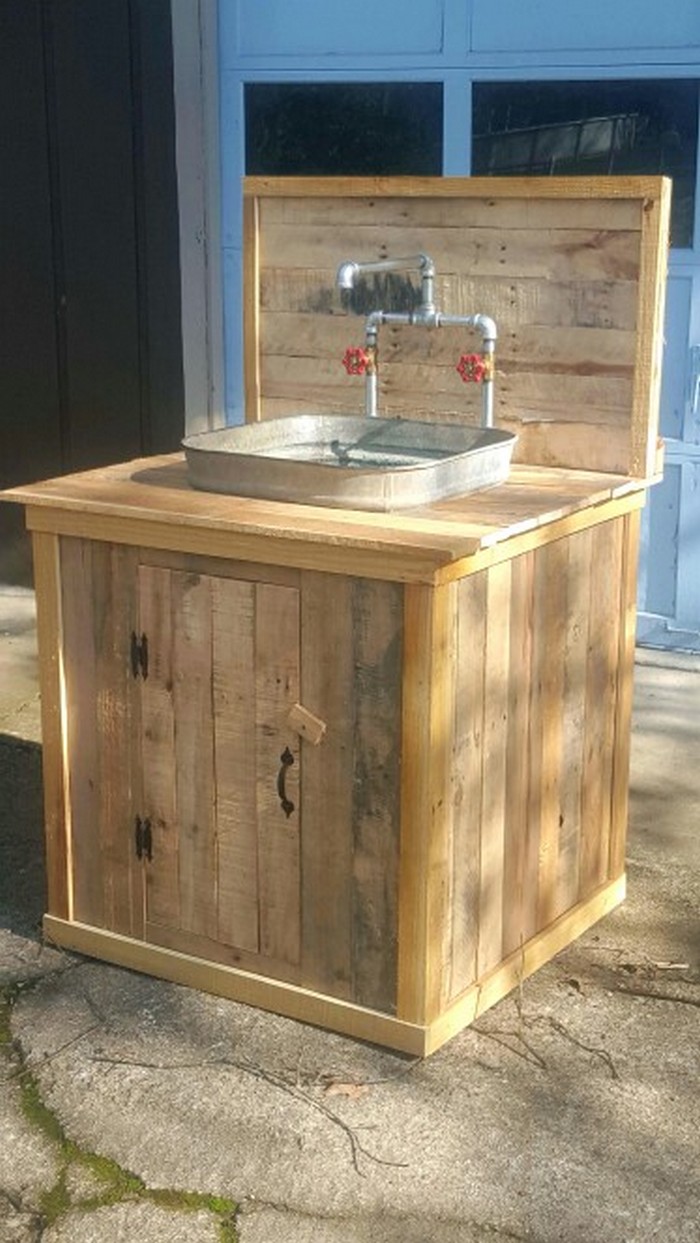
Sustainability and Eco-Friendly Options
Creating an outdoor sink not only adds convenience to your outdoor space but also presents a unique opportunity to embrace sustainability. By choosing eco-friendly options, you can reduce your environmental footprint while enjoying the practical benefits of your outdoor sink. Here’s how to make your outdoor sink project align with eco-friendly practices.
Use Repurposed Materials
Using repurposed materials for your outdoor sink is not just a step towards sustainability; it’s a creative journey that breathes new life into items with past stories. Here’s a deeper look into making this eco-friendly choice a centerpiece of your outdoor space.
Creativity Meets Sustainability
Choosing old wooden cable spools, wine barrels, and pallets for your sink project is a testament to creativity and environmental responsibility. These materials, often seen as end-of-life items, are sturdy, versatile, and full of character. By repurposing them, you’re not just reducing waste; you’re crafting a unique feature that has its history and charm.
The Beauty of Second Chances
Repurposed materials bring a rustic, authentic feel to any outdoor kitchen or garden. An old wine barrel can become a stylish sink that serves as a conversation piece, while a wooden cable spool can be transformed into a functional sink with a vintage touch. With their rugged look and durability, pallets offer a canvas for various sink designs. Each repurposed item adds a layer of beauty and uniqueness that new materials simply can’t match.
Environmental Impact
The decision to use repurposed materials for your outdoor sink significantly impacts the environment. It helps reduce the demand for new resources, lowers the amount of waste sent to landfills, and decreases the carbon footprint associated with manufacturing new products. This approach embodies the essence of sustainability, showing that eco-friendly choices can lead to functional, stylish outcomes.
Embracing repurposed materials for your outdoor sink project is a meaningful step towards a more sustainable lifestyle. It showcases how environmental consciousness and innovative design can create something truly special for your home.
Choose Sustainable Wood
Choosing sustainable wood for your outdoor sink project is a critical decision that reflects your commitment to environmental stewardship. This choice not only impacts the durability and appearance of your sink but also the health of our planet. Here’s a closer look at why sustainable wood is essential and how to select the right type for your project.
The Importance of Sustainable Wood
Sustainable wood comes from forests that are managed in a way that meets the needs of the present without compromising the ability of future generations to meet their own needs. When you choose sustainable wood, you support forestry practices that preserve biodiversity, protect water resources, and ensure the sustainability of the forest ecosystem. This approach helps mitigate climate change by reducing carbon emissions associated with deforestation and forest degradation.
FSC Certification: A Mark of Responsibility
The Forest Stewardship Council (FSC) is a global organization that sets standards for responsibly managed forests. Wood that is FSC-certified has been harvested according to these rigorous standards. Look for the FSC label when selecting wood for your outdoor sink. This certification is your assurance that the wood comes from forests where environmental, social, and economic practices are in balance.
Benefits Beyond the Environment
Using sustainable wood for your outdoor sink benefits the environment and adds value to your project. This type of wood often comes with a story of responsible management and a commitment to preserving natural resources. Additionally, FSC-certified wood is known for its quality, durability, and aesthetic appeal, making it an excellent choice for outdoor applications.
Making the Right Choice
When planning your outdoor sink, research suppliers that offer sustainable wood options. Ask about the origin of the wood and look for FSC certification to ensure you’re making an environmentally sound choice. By choosing sustainable wood, you contribute to the conservation of forests and wildlife, support responsible forestry practices, and invest in the longevity and beauty of your outdoor sink.
Opting for sustainable wood is a powerful step toward a more sustainable future. It shows that you value the environment and are willing to make choices that protect it. Your outdoor sink will be a functional addition to your space and a testament to your commitment to sustainability.
Implement Water-Saving Features
Implementing water-saving features in your outdoor sink is an effective way to contribute to environmental conservation while enhancing the functionality of your space. Here’s a deeper dive into how integrating such features reduces water usage and fosters a sustainable lifestyle.
Low-Flow Faucets: Efficiency Meets Innovation
Low-flow faucets are designed to limit the flow of water without compromising on performance. By incorporating aerators or flow restrictors, these faucets can significantly reduce water usage, often by up to 50%, compared to standard faucets. This technology ensures that you can still enjoy high water pressure while using less water, making it an ideal choice for your outdoor sink. Whether you’re washing hands, cleaning garden tools, or rinsing vegetables, low-flow faucets deliver the water you need with minimal waste.
Foot Pump Mechanisms: Hands-Free and Water-Wise
A foot pump mechanism to your outdoor sink setup introduces a hands-free, water-wise solution. This system allows you to control water flow with the tap of your foot, providing water only when you need it and reducing overall consumption. Foot pumps are especially useful in outdoor settings where your hands might be dirty from gardening or cooking. This method not only helps conserve water but also promotes hygiene by minimizing the need to touch faucet handles, reducing the spread of dirt and germs.
The Benefits of Water Conservation
By implementing water-saving features in your outdoor sink, you not only contribute to the conservation of this vital resource but also enjoy cost savings on your water bills. Reducing water usage in your outdoor activities helps alleviate the strain on local water supplies, particularly important in water scarcity areas. Moreover, these eco-friendly choices reflect a commitment to sustainable living, setting a positive example for your community.
Making the Switch
Transitioning to water-saving features in your outdoor sink is a straightforward process that yields long-term benefits. When selecting faucets or planning the installation of a foot pump, consider the specific needs of your outdoor space and how you typically use water. Many water-saving devices are easy to install and can be incorporated into existing sinks with minimal adjustments.
Adopting water-saving features for your outdoor sink is a smart move towards sustainability. It aligns with environmental conservation efforts while ensuring your outdoor living space remains functional and efficient.
Safety and Accessibility
Ensuring your outdoor sink is safe and accessible is key to creating a functional and inclusive outdoor space. This means designing a sink area that everyone can use comfortably, regardless of age or ability. Let’s explore how to achieve this with your outdoor sink project.
Prioritize Ergonomic Design
Ergonomics plays a crucial role in safety and accessibility. Design your outdoor sink at a comfortable height for both standing and seated users. Adjustable or multi-level counters can accommodate everyone, from children to adults, including those who may use wheelchairs. Also, consider lever-operated faucets which are easier to use than traditional twist knobs, especially for people with limited hand strength.
Ensure Slip-Resistant Surfaces
Outdoor areas are prone to becoming slippery, especially near water sources like sinks. To prevent falls and injuries, choose materials for the flooring around your outdoor sink that offer good traction even when wet. Textured tiles or slip-resistant mats can significantly reduce the risk of slips, ensuring a safer environment for everyone.
Optimize for Easy Access
Accessibility is about ensuring everyone can use the outdoor sink comfortably and safely. This includes clear pathways free from obstacles, ensuring the sink is reachable for everyone. If space allows, consider installing a sink with an open area underneath, making it accessible for someone in a wheelchair. Also, place commonly used items within easy reach and ensure the area is well-lit, removing barriers that might make the sink hard for people with visual impairments.
Install Proper Lighting
Good lighting is essential for safety and usability, particularly in the evening or on cloudy days. Install bright, energy-efficient LED lights overhead and consider task lighting to illuminate the sink area clearly. This will help everyone see what they’re doing, reducing the risk of accidents and making the space more accessible to those with visual impairments.
Use Color and Contrast
Incorporating color and contrast can greatly improve the accessibility of your outdoor sink area. Use contrasting colors between the countertop, sink, and fixtures to help outline these elements clearly. This is especially helpful for individuals with visual impairments, as it enhances their ability to distinguish different parts of the sink area.
Safe Storage Solutions
Keep the outdoor sink area clutter-free and safe by implementing smart storage solutions. Use cabinets and shelves to store cleaning agents, sharp tools, and other hazardous materials out of reach of children. Consider lockable storage for harmful substances to prevent accidental ingestion or misuse, ensuring a safer environment for everyone.
Temperature Control Features
To prevent the risk of scalding, especially important in settings where children or individuals with sensitive skin may use the sink, install faucets with anti-scald features or temperature control valves. These devices can limit the maximum water temperature to a safe level, ensuring the water is never too hot to the touch.
Clear Signage
For public or shared outdoor sinks, clear signage can improve accessibility. Use signs to indicate the operation of the sink, any safety warnings, and instructions for use. Braille signs and symbols with high contrast can also make the sink more accessible to individuals with visual impairments.
By focusing on safety and accessibility, you make your outdoor sink welcoming and usable for all your friends and family. This enhances the enjoyment of your outdoor space and aligns with the principles of inclusive design, ensuring everyone can participate in outdoor activities together.
FAQ on Sustainable Outdoor Sinks
Can I make an outdoor sink from any old wooden cable spool?
What makes a wine barrel sink a luxury addition to outdoor spaces?
How can I ensure my garden sink is mobile?
Is it difficult to install water-saving features in an outdoor sink?
How do I maintain the sustainability of my outdoor sink?
Can I customize my outdoor sink to match my garden’s aesthetic?
Are there any considerations for the placement of an outdoor sink?
How can I ensure my outdoor sink is accessible to everyone?
Conclusion
Creating a unique and sustainable outdoor sink is an achievable and rewarding project. By repurposing materials like wooden cable spools, wine barrels, and pallets, you can add a touch of character and eco-friendliness to your outdoor space. Opting for sustainable wood and implementing water-saving features further enhances the environmental benefits of your outdoor sink.


